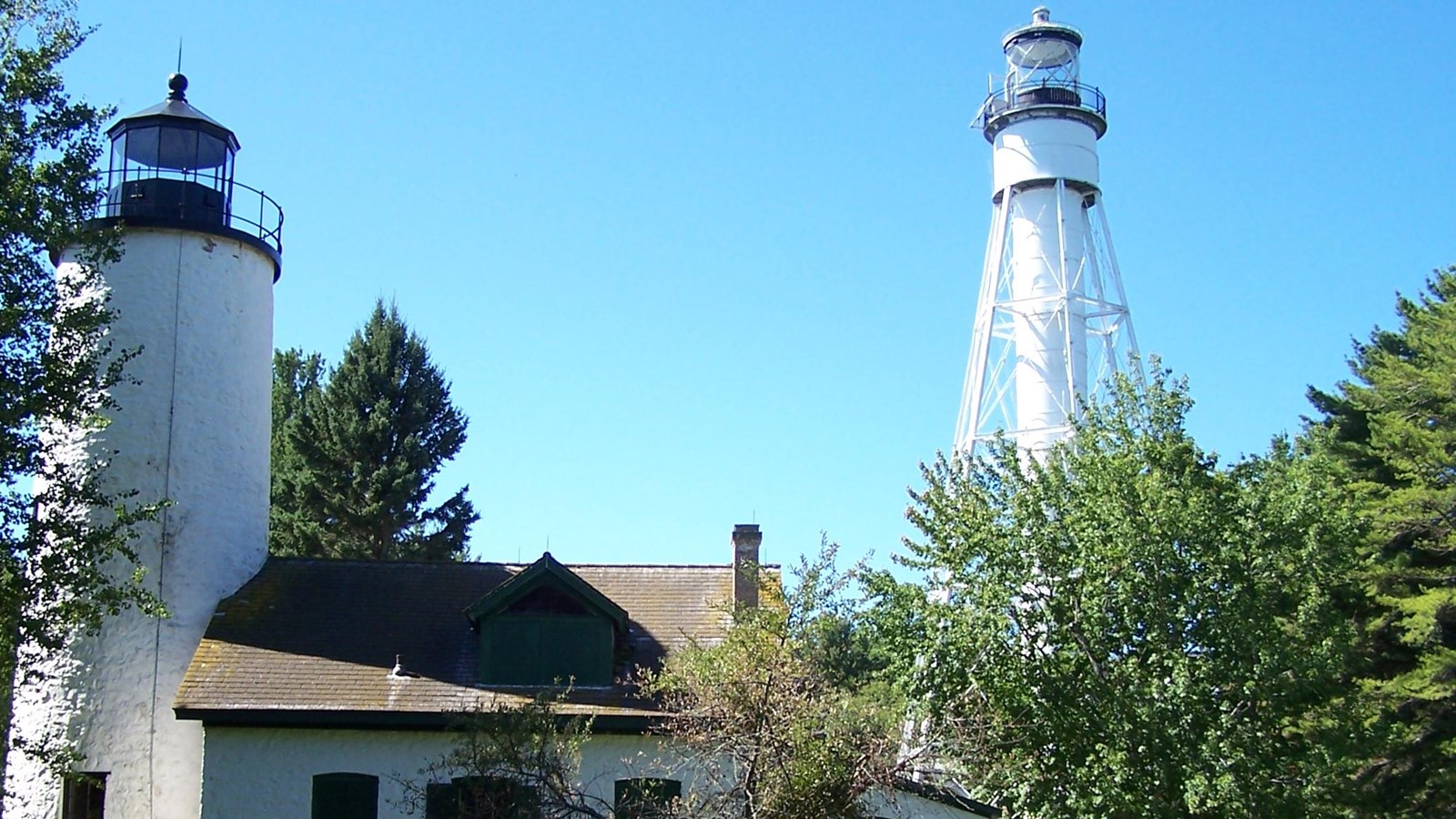Last updated: October 1, 2021
Place
Michigan Island

NPS Photo
Automated External Defibrillator (AED), Beach/Water Access, Canoe/Kayak/Small Boat Launch, Dock/Pier, First Aid Kit Available, Historical/Interpretive Information/Exhibits, Information - Ranger/Staff Member Present, Scenic View/Photo Spot, Toilet - Vault/Composting, Trailhead
Bagidaabii-minis (Michigan Island) is located 16 miles from Bayfield and is one of the farthest west islands in the archipelago. It is a small island of only 1.1 miles in width and has 8.3 miles of shoreline. A unique and controversial lighthouse history lead to the island having not one, but two lighthouses. Camping, hiking, boating, and history await you on Michigan Island.
Camping and Hiking
There is one campsite available on Michigan Island that can be reserved on Recreation.gov. A one mile sand spit hiking trail starts behind the light station at the vault toilets and goes to the sand spit and campsite on the southwest corner of the island. A small dock is available for boats below the lighthouse at a first come first serve basis.
Lighthouse
The story of the Michigan Island Light Station embodies the sweeping changes overtaking the Lake Superior region during a turning point in history. Living at a light station was much like it was at an isolated rural farm in the nineteenth century. Food and supplies had to be brought in by boat or else produced or collected on the island. Hunting, fishing, and berry picking throughout the islands was common practice. In the late 1800s a tramway was built to help haul supplies up the incline to the lighthouse from the dock. Roswell Pendergast, Keeper from 1869-1874, planted exstensive apple, cherry, peach, plum, and pear trees in the 1870s, and in the twentieth century the Lane family maintained and expanded the orchards. NPS staff have re-planted and maintain these orchards for visitors to enjoy.
A Change In Plans
There are two light towers at Michigan Island. One was supposed to be built somewhere else and the second originally was elsewhere! The original plans called for the lighthouse to be built on Long Island, to guide ships to the port of LaPointe, on Madeline Island. Since LaPoint harbor was on the west side of the island, the lighthouse inspector suggested placing the light on Long Island, where it would be visible to ships approaching from the east. However, for reasons that are not completely clear, a Lighthouse Service official ordered a last-minute change of plans, and the lighthouse was built on Michigan Island, instead. Made of rough stone, its exterior walls stuccoed and whitewashed, the new lighthouse combined a small, one-and-a-half-story keeper's dwelling with a low, conical light tower.
The light on Michigan Island entered service in the spring of 1857, but was closed after only one year of operation. Evidence suggests that higher authorities in the Lighthouse Service repudiated the rash decision of their field representative, and ordered the hapless contractors to go back and erect a new lighthouse at the planned Long Island location. For more than a decade, the Michigan Island tower sat vacant, and in the harsh Lake Superior climate, it quickly began to deteriorate. In 1869, however, authorities decided that a lighthouse on Michigan Island might actually be useful, so $6000 was appropriated to repair the building and relight the light. The refurbished light was equipped with a three-and-a-half order Fresnel lens.
Fifty years later, an effort began to place the Michigan Island light in a higher tower. When the Lighthouse Service discontinued operation of the Schooner's Ledge light on Pennsylvania's Delaware River near Philadelphia, the cylindrical steel tower was disassembled and brought to Wisconsin. Originally built in 1880, the tower was transported to Michigan Island in 1919, where it sat on the beach, awaiting assembly, for another ten years. The light station experienced a series of improvements in 1928 and 1929. A brick building was constructed to house an electric generator, a radio fog beacon, and a hoist engine for a tramway; a new keeper's dwelling was added; and the relocated tower was finally assembled. At 112 feet in height, the new tower became the tallest lighthouse in Wisconsin.
Lamps and Lightkeeper Ed Lane
As technology changed, each Michigan Island keeper had to learn to adapt. The first lamps burned lard oil, then in 1880 came the switch to kerosene, also known as mineral oil. In about 1914, the incandescent oil vapor lamp added air under pressure to kerosene. The fine vapor burned brighter in a mantle and used less fuel. The Michigan Island Light converted to electricity in 1929 when the new steel tower was put into use.Ed Lane was the light keeper at Michigan Island from 1901 until he retired from the U.S. Lighthouse Service in 1939, when the lighthouse board ceased to exist. This is the longest period of time that any keeper spent at a single Apostle Islands light station. On October 29, 1929 Ed noted in the lighthouse logbook,
"Put window shades and worked in old tower. Started up new tower at sunset. Everything in good shape, but station looked odd, the old tower being dark for the first time in navigation in 60 years."
The U.S. Coast Guard took charge of all American lighthouses starting in 1940. A young Coast Guardsman, Elseworth Riske, moved into the quarters formerly occupied by the Lake family. Though the uniform changed, much remained the same.The Michigan Island light was automated in 1943. The Fresnel lens was removed from the tower in 1972 and is now on display in the National Lakeshore Visitor Center in Bayfield.
Visiting the Light Station
Visiting Michigan Island can be a challenge. Only the most experienced private boaters and sea kayakers should consider attempting a trip to this lighthouse due to the great distance and exposed location. Even when lake conditions permit approach, the exposed location of the dock often makes landing impossible. Volunteers are usually available for Memorial Day - Labor Day for tours.
